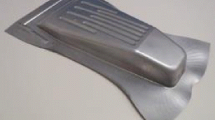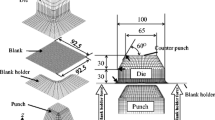Abstract
Blank holder force (BHF) is one of the important process parameters for successful sheet metal forming. Variable blank holder force (VBHF) that the BHF varies through the forming process is recognized as an advanced forming technology. It has also been reported that segmented VBHF (S-VBHF) is valid to a complex shape forming, but the optimal S-VBHF trajectories are rarely discussed and used. In addition to BHF, blank shape has an influence on the product quality. The blank shape minimizing the earing is still an important issue in sheet metal forming. Simultaneous optimization of both S-VBHF trajectories and blank shape is one of the crucial issues in industries. This paper proposes a method to simultaneously optimize both the segmented VBHF trajectories and the blank shape. Numerical simulation in sheet metal forming is so intensive that a sequential approximate optimization (SAO) using a radial basis function (RBF) network is adopted for the simultaneous design optimization. Based on the numerical result, the experiment using the AC servo press (H2W300, Komatsu Industry Corp.) that can conduct the optimal S-VBHF trajectories is carried out. It has been confirmed from the numerical and experimental result that the proposed approach is valid.
Similar content being viewed by others
References
Obermeyer EJ, Majlessi SA (1998) A review of recent advances in the application of blank-holder force towards improving the forming limits of sheet metal parts. J Mater Process Technol 75:222–234
Hsu CW, Ulsoy AG, Demeri MY (2000) An approach for modeling sheet metal forming for process controller design. J Manuf Sci Eng 122:717–724
Manabe K, Koyama H, Yoshihara S, Yagami T (2002) Development of a combination punch speed and blank-holder fuzzy control system for the deep-drawing process. J Mater Process Technol 125-126:440–445
Sheng ZQ, Jirathearanat S, Altan T (2004) Adaptive FEM simulation for prediction of variable blank holder force in conical cup drawing. International Journal of Machine Tools & Manufacturing 44:487–493
Lo SW, Yang TC (2004) Closed-loop control of the blank holding force in sheet metal forming with a new embedded-type displacement sensor. Int J Adv Manuf Technol 24:553–559
Lin ZQ, Wang WR, Chen GL (2007) A new strategy to optimize variable blank holder force towards improving the forming limits of aluminum sheet metal forming. J Mater Process Technol 183:339–346
Yagami T, Manabe K, Yamauchi Y (2007) Effect of alternating blank holder motion of drawing and wrinkle elimination on deep-drawability. J Mater Process Technol 187-188:187–191
Kitayama S, Hamano S, Yamazaki K, Kubo T, Nishikawa H, Kinoshita H (2010) A closed-loop type algorithm for determination of variable blank holder force trajectory and its application to square cup deep drawing. Int J Adv Manuf Technol 51:507–571
Wang WR, Chen GL, Lin ZQ, Li SH (2007) Determination of optimal blank holder force trajectories for segmented binders of step rectangle box using PID closed-loop FEM simulation. Int J Adv Manuf Technol 32:1074–1082
Jakumeit J, Herdy M, Nitsche M (2005) Parameter optimization of the sheet metal forming process using an iterative parallel Kriging algorithm. Struct Multidiscip Optim 29:498–507
Wang H, Li G, Yao Z, Zhi H (2008) Optimization of sheet metal forming processes by adaptive response surface based on intelligent sampling method. J Mater Process Technol 197:77–88
Kitayama S, Kita K, Yamazaki K (2012) Optimization of variable blank holder force trajectory by sequential approximate optimization with RBF network. J Adv Manuf Technol 61(9–12):1067–1083
Kitayama S, Huang S, Yamazaki K (2013) Optimization of variable blank holder force trajectory for springback reduction via sequential approximate optimization with radial basis function network. Struct Multidiscip Optim 47(2):289–300
Park SH, Yoon JH, Yang DY, Kim YH (1999) Optimum blank design in sheet metal forming by the deformation path iteration method. International Journal of Mechanical Science 41:1217–1232
Wang J, Goel A, Yang F, Gau JT (2009) Blank optimization for sheet metal forming using multi-step finite element simulations. Int J Adv Manuf Technol 40:709–720
Vafaeesefat A (2011) Finite element simulation for blank shape optimization in sheet metal forming. Mater Manuf Process 26:93–98
Fazli A, Arezoo B (2012) A comparison of numerical iteration based algorithms in blank optimization. Finite Elem Anal Des 50:207–216
Oliveira MC, Padmanabhan R, Baptista AJ, Alves JL, Menezes LF (2009) Sensitivity study on some parameters in blank design. Mater Des 30:1223–1230
Hino R, Yoshida F, Toropov VV (2006) Optimum blank design for sheet metal forming based on the interaction of high- and low-fidelity FE models. Arch Appl Mech 75(10):679–691
Naceur H, Ben-Elechi S, Batoz JL, Knopf-Lenoir C (2008) Response surface methodology for the rapid design of aluminum sheet metal forming parameters. Mater Des 29:781–790
Liu Y, Chen W, Ding L, Wang X (2013) Response surface methodology based on support vector regression for polygon blank shape optimization design. Int J Adv Manuf Technol 66:1397–1405
Meng D, Zhao S, Li L, Liu C A servo-motor driven active blank holder control system for deep drawing process. Int J Adv Manuf Technol. doi:10.1007/s00170-016-8723-0
Kitayama S, Arakawa M, Yamazaki K (2011) Sequential approximate optimization using radial basis function network for engineering optimization. Optim Eng 12(4):535–557
Hillmann, M., Kubli, W., (1999), Optimization of sheet metal forming processes using simulation programs, in: Numisheet ‘99, Beasnc, France, 1: 287–292.
Manoochehri M, Kolahan F (2014) Integration of artificial neural network and simulated annealing algorithm to optimize deep drawing process. Int J Adv Manuf Technol 73:241–249
Hosseini A, Kadkhodayan M (2014) A hybrid NN-FE approach to adjust blank holder gap over punch stroke in deep drawing process. Int J Adv Manuf Technol 71:337–355
Meng D, Zhao S, Li L, Liu C (2016) A servo-motor driven active blank holder control system for deep drawing process. Int J Adv Manuf Technol 87:3185–3193
Kitayama S, Natsume S, Yamazaki K, Han J, Uchida H (2016) Numerical investigation and optimization of pulsating and variable blank holder force for identification of formability window for deep drawing of cylindrical cup. Int J Adv Manuf Technol 82:583–593
Mostafapour A, Akbari A, Nakhaei MR Application of response surface methodology for optimization of pulsating blank holder parameters in deep drawing process of Al 1050 rectangular parts. Int J Adv Manuf Technol. doi:10.1007/s00170-016-9781-z
Ozturk E, Turkoz M, Halkaci HS, Koc M Determination of optimal loading profiles in hydromechanical deep drawing process using integrated adaptive finite element analysis and fuzzy control approach. Int J Adv Manuf Technol. doi:10.1007/s00170-016-8912-x
Xiao Y, Zhang H, Jiang Z (2016) An approach for blank dimension design considering energy consumption. Int J Adv Manuf Technol 87:1229–1235
Author information
Authors and Affiliations
Corresponding author
Rights and permissions
About this article
Cite this article
Kitayama, S., Koyama, H., Kawamoto, K. et al. Optimization of blank shape and segmented variable blank holder force trajectories in deep drawing using sequential approximate optimization. Int J Adv Manuf Technol 91, 1809–1821 (2017). https://doi.org/10.1007/s00170-016-9877-5
Received:
Accepted:
Published:
Issue Date:
DOI: https://doi.org/10.1007/s00170-016-9877-5




